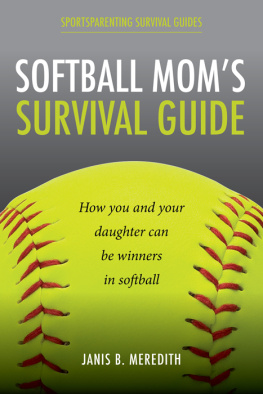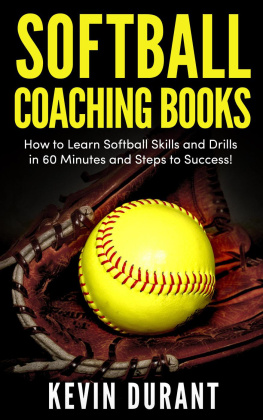Softball Moms Survival
Guide
How you and your daughter can be winners in softball
By Janis Meredith
Copyright 2013 Janis Meredith
All rights reserved. No part of this publication may be copied, except by permission of the copyright holder.
Cover design by Imagine! Studios, LLC
ArtsImagine.com
Dedicated to my wonderful daughter, Cristi. Your dad and I are so proud of you and have loved watching you grow up to become the woman you are today. The journey of softball that you took us on was as life changing for us as it was for you.

The very first time my daughter put on a softball uniform and took the field with eight other girls, she was hooked. Forget gymnastics and ballet; my social 8-year-old fell in love with team sports and, as she continued to play softball, found a sport she would love for many years.
She played for fifteen yearsthrough middle school, high school, and college. Even now as a first-year kindergarten teacher, she plays in a slow-pitch league.
Little did we know when she began playing how much softball would invade our lives over the next decade and a half.
At first it was the local little league, then Amateur Softball Association of America (ASA) travel teams, then middle school, more ASA, high school, more ASA, then college. At some pointI think it was when she played in the local city leagueher dad started to coach her teams when no one else would step up. And that started another journey in our family. My husband went on to coach softball for ten years, ending his softball coaching career as a two-time sectional championship varsity head coach.
I had no choice but to become the dedicated softball mom and wife. And despite the many trips, tense father-coaching-daughter moments, money spent, and crazy schedules (we had two other kids in sports too!), coupled with the usual frustrations of being a sports parentyou know them: playing time, team drama, coaching issuesI can honestly say that I loved being a softball mom.
I truly hope if you are just beginning your softball journey, or are well into it, that you will experience as much joy from seeing your daughter play as I did.
Thats why Ive written this book. I want to help you get the most out of your daughters softball playing experience. And by doing that, I know that I am also helping your daughter get the most out of her softball experience. Its funny how those two are so closely tied together.
The tips and suggestions in this book vary from the practicalsafety, nutrition, sports equipmentto the emotionalteam drama, mental toughness, dealing with Dad.
Its a survival guide written with the single purpose in mind: to help both you and your daughter be winners in softball.
Id love to hear from you after youve read the book. Please feel free to email me at .
Chapter 1
There is nothing more gut-wrenching than to see your daughter get injured in sports. Some may assume that because softball is not a rough-and-tumble sport that injuries are less likely than in a sport like basketball or soccer.
Lets set the record straight. Softball is not a sport for sissified young ladies. Girls get injured playing softball all the time. Ive seen knee over-extensions, tweaked ankles, ball bruises and injuries, even broken bones.
My daughter played catcher during most of her softball career and I would cringe every time someone slid into home. She got knocked over and run into often, and, fortunately for her, she was able to stand her ground most of the time and guard the plate. But often, it was not a pretty sight.
So if youre considering softball as a sport for your daughter because it somehow seems safer, think again. According to Safe Kids USAa national network of organizations working to prevent childhood injurythe top five sports for injuries are:
- Baseball/softball
- Basketball
- Football
- Hockey
- Lacrosse
You want a safe sport? Maybe try ping-pong or chess or golf!
When you sign your daughter up for softball, you are also signing her up for the possibility of injury. Its just part of the game.
However, dont let that stop you from signing on the dotted line. Your daughter will spend more of her softball playing time injury-free than she will on the bench recovering. And there are steps you and your daughter can take to help prevent injuries.
Help Prevent Injuries by Being AWARE
Sports safety is a number one concern for most sports parents. It's a fact of life that athletes get hurt when playing sports. But there are ways to help prevent injuries.
They are simple ways, really. Not rocket science. But the problem is, even though sports parents and athletes know these common-sense guidelines, they still forget to practice them. Let's make it easy: just remember to be AWARE:
Always warm up
Wear protective gear
Avoid playing when injured or in pain
Rest
Eat right and exercise
Always Warm Up
Warming up is never a waste of time. Muscles that have been stretched and warmed up are less likely to be injured. My kids tend to be tight-muscled, and when they skip the pre-game or pre-practice stretching, they often suffer for it.
Dr. Peggy Malone, a chiropractor and athlete who helps athletes overcome injury, explains, A five- to ten-minute warm-up gets blood pumping to your muscles and soft tissues and warms up your musculoskeletal system. As your body generates heat, your connective tissues soften and become more pliable and are than less likely to get injured.
She warns that the No. 1 reason athletes get injured is that they disobey the rule of the Terrible Toos.
TOO MUCH
TOO FAST
TOO SOON
Malone explains: If you push your training too much, too fast, too soon, you will end up injured. This rule is especially relevant for beginners, anyone who has just come back to a sport after months or years off, and anyone who has been injured in the last three to six months.
Your daughters coach should spend plenty of time with team warm-ups. If he or she doesnt, be sure your daughter warms up on her own before practices and games.
Wear and Use the Right Equipment
Your daughter is not a wimp for wearing protective gear. If she needs ankle braces, a mouth guard, a face mask (for playing the infield or pitching), then be sure she is equipped with the proper protection.
Once youve decided what equipment she needs to wear, make sure you have the right gear for your daughters needs. Theres a lot of glitz and hype when it comes to marketing sports equipment. Do your homework and choose what is best for your daughter.
It is recommended that sports shoes be replaced every six months or every five hundred miles. Theres nothing worse than playing in shoes that have no grip or dont fit right or are really worn down.
Having the right sports equipment not only protects your daughter, but it also gives her confidence as she plays. Be sure you get help from a professional in choosing the best equipment for your daughter. We were always careful about getting the proper equipment for our catcher daughter. We never scrimped on her safety.
Avoid Playing When Injured or in Pain
Pain indicates a problem. You must help your daughter learn to heed warning signs from her body. Of course, if the pain is the result of a specific injury and it persists, it should be checked out by a doctor.
There may be times when it is a minor injury and the doctor says it is okay to play if she can take the discomfort. When my daughter heard the doctor say that, she always played, disregarding the pain. As long as the doctor says playing on it will not cause any more damage, then it is really a choice for your daughter to make as to whether she can stand to play with the pain.
Next page















